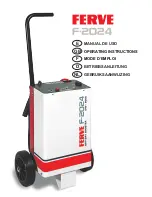
Partial Off
This mode is entered by momentarily pressing the ESC Off switch
.
This mode is intended
for times when a more spirited driving experience is desired
.
It is also intended for driv-
ing in deep snow, sand or gravel conditions, when more wheel spin than ESC would nor-
mally allow is required to gain traction
.
To turn ESC on again, momentarily press the
switch again
.
This will restore the normal ESC On mode of operation
.
Full Off
This mode is intended for off-highway or off-road use only and should not be used on
public roadways
.
In this mode, all TCS and ESC stability features are turned OFF, except
for the limited slip feature described in the TCS section
.
To enter the “Full Off” mode,
depress and hold the ESC OFF switch for five seconds
.
After five seconds, the ESC OFF
Indicator Light will illuminate, and the “ESC OFF” message will display in the EVIC
.
To turn
ESC ON again, momentarily press the ESC OFF switch
.
- Electronic Stability Control (ESC) Activation / Malfunction
Indicator Light
The “ESC Activation/Malfunction Indicator Light” in the instrument cluster will come on
for four seconds when the ignition switch is turned to the ON/RUN position
.
If the “ESC
Activation/Malfunction Indicator Light” comes on continuously with the engine running, a
malfunction has been detected in the ESC system
.
If this light remains on, see your
authorized dealer as soon as possible to have the problem diagnosed and corrected
.
NOTE:
•
The “ESC Off Indicator Light” and the “ESC Activation/Malfunction Indicator Light”
come on momentarily each time the ignition switch is turned to ON/RUN
.
•
Each time the ignition is turned to ON/RUN, the ESC system will be ON even if it
was turned off previously
.
•
ESC Activation/Malfunction Light can blink during a ESC or TC intervention
.
- Tire Pressure Monitoring System (TPMS) Light
•
Each tire, including the spare (if provided), should be checked monthly when cold and
inflated to the inflation pressure recommended by the vehicle manufacturer on the
vehicle placard or tire inflation pressure label
.
(If your vehicle has tires of a different
size than the size indicated on the vehicle placard or tire inflation pressure label, you
should determine the proper tire inflation pressure for those tires
.
)
•
As an added safety feature, your vehicle has been equipped with a Tire Pressure Moni-
toring System (TPMS) that illuminates a low tire pressure telltale when one or more
of your tires is significantly under-inflated
.
Accordingly, when the low tire pressure tell-
tale illuminates, you should stop and check your tires as soon as possible, and inflate
them to the proper pressure
.
Driving on a significantly under-inflated tire causes the
tire to overheat and can lead to tire failure
.
Under-inflation also reduces fuel efficiency
and tire tread life, and may affect the vehicle’s handling and stopping ability
.
WHAT TO DO IN EMERGENCIES
57
Summary of Contents for 2014 500e
Page 1: ...2 014 USER GUIDE ...
Page 75: ...UNDERHOOD COMPARTMENT MAINTAINING YOUR VEHICLE 73 ...
Page 90: ...NOTES 88 ...
















































